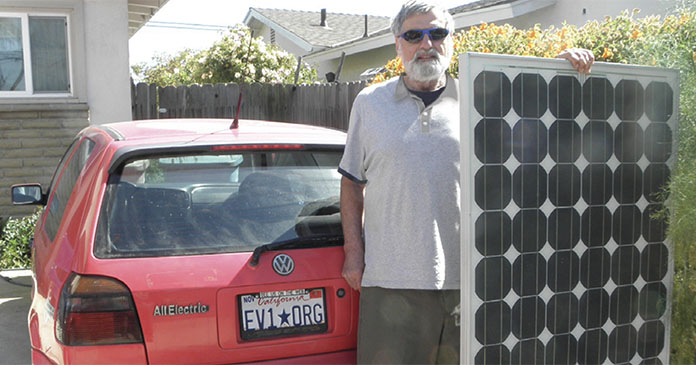The advent of plug-in cars, or “EVs,” has been hyped-up beyond the fad level. There now may be 3,000 plug-in cars out of our national fleet of 300,000,000 oil-fired cars. Even under the most optimistic assumptions, those worrying about the “horde of EVs” bringing the electric grid to its knees are really, as Tesla’s Elon Musk recently opined, worrying about pastures for unicorns—before there are any unicorns.
The last time plug-ins were produced, a Northern California company called EVI reputedly made more money from grants than from the EV chargers themselves, which, in effect, disconnected the EV fleet from plugging-in to wall outlets. And it’s not even a charger. It’s really just a costbased electric dispenser.
Every plug-in car has its charger already on-board. So-called EV chargers are unnecessary relays that ensure that an EV handshakes with them. EVs can be plugged into a wall socket, either 120V or 240V, and the work of charging is done by the on-board inverter and battery management system.
Now again, we have companies competing for grant money to install pay-for-charge units, which release electric energy to the EV for a price.
The problem is that there is no business model for this function that makes economic sense—or enough revenue to make it investment-attractive. Mostly, such companies are after government grants.
Electric cars are very efficient: the average drive of 30 miles takes at most 8 kilowatt hours (“kWh,” that thing on your electric bill that costs about 12 cents). So to fill up the EV for the average drive takes about $1 of electric energy.
The cost profile of an EV, like an electric forklift, is higher up-front cost, but maintenance and fuel costs are much lower. The advantage of an EV is lost if electric fuel becomes too expensive. Most EV drivers install rooftop solar electric systems so that they can drive on energy they make themselves and the savings from not buying gasoline pays for the solar system.
Similarly, the charging profile of an EV differs from oil-fired cars: EVs charge during the hours they are sitting, unused, while oilfired cars refuel episodically, and then sit waiting, full, unused.
Electric cars refuel slowly, off-peak, usually at night, at the driver’s home. Charging typically takes more than an hour. During the daily grind, the EV can charge opportunistically.
Neither all-night, nor opportunistic charging, offers an opportunity to provide a service-for-pay.
Apartment/condo cost-based charging
The cost of the EV parking space, approximately $10,000, dwarfs the $3,000 cost of the charging unit, not to mention the cost of installing and monitoring.
Secondly, experience proves that the expensive relays, unlike regular plugs, often fail. Maintenance is a big cost item.
If the average drive requires 8 kWh, after the EV fills up, it still occupies the dedicated EV-charging parking space. So, the most that can be dispensed for each day under the apartment-dweller model is $1 of electric. Why wouldn’t the apartment dweller just plug-in the on-board charger to a normal electric outlet at a cost of $1? That’s what most EV drivers do, and some condo owners have installed dedicated circuits on their parking spaces at their own cost.
If the driver is billed, as one such company proposes, $150 per month, that would be $5 per day, or about five times the cost of electric—not counting the cost of the dedicated parking space. That $150/month would put fueling of the EV on a par with refueling at a gas station; moreover, there is not enough of a margin to support the company providing the cost-based dispensers, even if all 3,000 EVs in the country were using the system.
Opportunity charging
Current opportunity chargers, for example at Costco or airports, are made available at no charge, for the very cogent reason that the amount of electric used is not worth billing. In one typical shopping trip to Costco where the EV driver spent $150 on goods, the EV received .5 kWh—about six cents worth of electric energy. Costco, and other providers like Walmart, LAX and various cities decided there was no revenue stream from charging for electric energy during “opportunity” or transitory charging.
One study purports that if there were meters on the charging stations at places like Costco and Walmart, EV drivers would not use them because they are not in the store long enough to achieve a significant charge.
Experience, thus informs us, that there isn’t a business here. The struggling, nascent EV fleet needs all the help it can get, including more charging spots, standardized chargers, and easy access to the electric grid for all levels of charging, as recreational vehicles are allowed.
The pay-for-electric idea is just one more parasitical impediment to plug-in cars.
Even worse, as noted by Marc Geller, cofounder and member of the board of directors of the San Francisco chapter of the Electric Auto Association, the city of San Francisco used grant money to convert free legacy outlets to for-profit Coulomb units, actually decreasing the number of available charge spots, and using government money to put one more barrier in the path of plugin EVs.
Author: Doug Korthof















